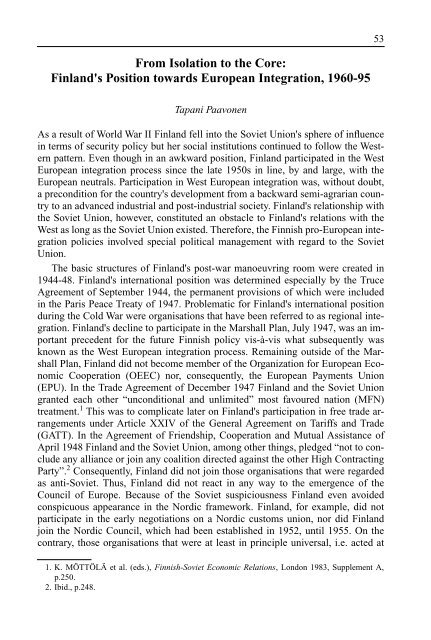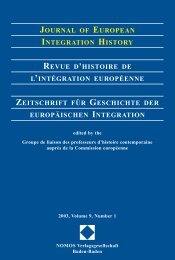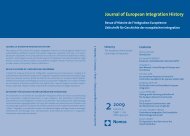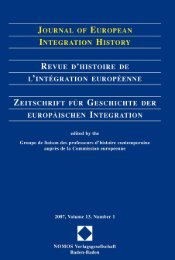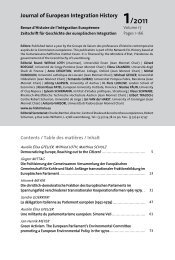journal of european integration history revue d'histoire de l ...
journal of european integration history revue d'histoire de l ...
journal of european integration history revue d'histoire de l ...
You also want an ePaper? Increase the reach of your titles
YUMPU automatically turns print PDFs into web optimized ePapers that Google loves.
From Isolation to the Core:<br />
Finland's Position towards European Integration, 1960-95<br />
Tapani Paavonen<br />
As a result <strong>of</strong> World War II Finland fell into the Soviet Union's sphere <strong>of</strong> influence<br />
in terms <strong>of</strong> security policy but her social institutions continued to follow the Western<br />
pattern. Even though in an awkward position, Finland participated in the West<br />
European <strong>integration</strong> process since the late 1950s in line, by and large, with the<br />
European neutrals. Participation in West European <strong>integration</strong> was, without doubt,<br />
a precondition for the country's <strong>de</strong>velopment from a backward semi-agrarian country<br />
to an advanced industrial and post-industrial society. Finland's relationship with<br />
the Soviet Union, however, constituted an obstacle to Finland's relations with the<br />
West as long as the Soviet Union existed. Therefore, the Finnish pro-European <strong>integration</strong><br />
policies involved special political management with regard to the Soviet<br />
Union.<br />
The basic structures <strong>of</strong> Finland's post-war manoeuvring room were created in<br />
1944-48. Finland's international position was <strong>de</strong>termined especially by the Truce<br />
Agreement <strong>of</strong> September 1944, the permanent provisions <strong>of</strong> which were inclu<strong>de</strong>d<br />
in the Paris Peace Treaty <strong>of</strong> 1947. Problematic for Finland's international position<br />
during the Cold War were organisations that have been referred to as regional <strong>integration</strong>.<br />
Finland's <strong>de</strong>cline to participate in the Marshall Plan, July 1947, was an important<br />
prece<strong>de</strong>nt for the future Finnish policy vis-à-vis what subsequently was<br />
known as the West European <strong>integration</strong> process. Remaining outsi<strong>de</strong> <strong>of</strong> the Marshall<br />
Plan, Finland did not become member <strong>of</strong> the Organization for European Economic<br />
Cooperation (OEEC) nor, consequently, the European Payments Union<br />
(EPU). In the Tra<strong>de</strong> Agreement <strong>of</strong> December 1947 Finland and the Soviet Union<br />
granted each other “unconditional and unlimited” most favoured nation (MFN)<br />
treatment. 1 This was to complicate later on Finland's participation in free tra<strong>de</strong> arrangements<br />
un<strong>de</strong>r Article XXIV <strong>of</strong> the General Agreement on Tariffs and Tra<strong>de</strong><br />
(GATT). In the Agreement <strong>of</strong> Friendship, Cooperation and Mutual Assistance <strong>of</strong><br />
April 1948 Finland and the Soviet Union, among other things, pledged “not to conclu<strong>de</strong><br />
any alliance or join any coalition directed against the other High Contracting<br />
Party”. 2 Consequently, Finland did not join those organisations that were regar<strong>de</strong>d<br />
as anti-Soviet. Thus, Finland did not react in any way to the emergence <strong>of</strong> the<br />
Council <strong>of</strong> Europe. Because <strong>of</strong> the Soviet suspiciousness Finland even avoi<strong>de</strong>d<br />
conspicuous appearance in the Nordic framework. Finland, for example, did not<br />
participate in the early negotiations on a Nordic customs union, nor did Finland<br />
join the Nordic Council, which had been established in 1952, until 1955. On the<br />
contrary, those organisations that were at least in principle universal, i.e. acted at<br />
1. K. MÖTTÖLÄ et al. (eds.), Finnish-Soviet Economic Relations, London 1983, Supplement A,<br />
p.250.<br />
2. Ibid., p.248.<br />
53


